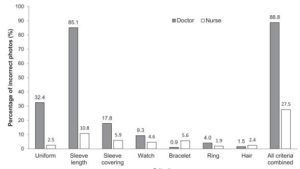Recently we discussed why healthcare-workers (HCW) should not wear rings, watches, long-, polished-, or artificial nails during patient care. Are these suggestions well known among HCW and patients?
We already mentioned Spierings et al. 2015 studies earlier this year, now we would like to present them more comprehensively. They examined how does a stereotypical image of a doctor or a nurse look like, and whether these stereotypes match with the infection control guidelines. They searched large stock photo websites (like shutterstock, 123rf, gettyimage, istockphoto, etc.) for “doctor” and “nurse” keywords. Pictures were analyzed along 7 criteria (as seen in Table 1), based on the “Personal hygiene of health care workers” protocol by the Dutch Working Party for Infection Control (WIP) [1].
Table 1: Criteria of correct and incorrect practice. Source: Spierings et al. 2015
Appropriate clothing of MDs in these photos were quite rare; 89% of photos contained at least one incorrect element. In most of the pictures, doctors wore long sleeve coat, despite that even the WHO hand hygiene guideline claims that long sleeves should be avoided [1, 2].
Figure 1: Percentage of incorrect clothing and toilet in photos. Source: Spierings et al. 2015
The stereotypical image does not agree with the current infection control guidelines. Spierings et al. conclude that “for higher compliance rates of HCW, we need to change the social image of doctors” [2].
Ponce de León Rosales et al. 2005 analyzed 100 episodes from the television series “ER”, a popular medical drama that shows everyday life of an emergency room. They identified the hand hygiene moments, and recorded whether actors performed it or not. Of the 1446 opportunities, only 0.20% were actually taken. Although everyone knows that it is a fiction and aims to be entertaining, authors discussed that lack of attention given to hand hygiene is noteworthy. Popular television series have educational effect. Showing less than 1% hand hygiene compliance to the audience is dangerous, conveying the wrong message that infection prevention is unnecessary [3].
Unfortunately, we can see non-compliance in the news too, see some example in Figure 2.
Figure 2: A) A doctor from an eminent teaching hospital wearing long sleeve white coat and ring.
B) HCW wearing long sleeve coat, bracelet, watch, ring.
Source: CNN, A [link], B [link]
There can be several reasons for this:
- maybe these hospitals have less rigorous infection prevention regulations, that does not forbid wearing long sleeve coat and jewelry during patient care,
- maybe these are not allowed, yet the regulations are not controlled/audited among hospital staff regularly.
Anyhow, changing the stereotypical image of HCW can help the hospital staff to be more compliant to guidelines.
CONCLUSION:
Media create stereotypes how healthcare workers (HCW) look like or behave. These stereotypes are not conforming with current infection prevention guidelines. Media paints false image to the potential patients and even to HCW, that could have adverse effect to patient safety measures compliance.
Read our previous posts on why HCW should not wear rings, watches, artificial/polished/long nails during patient care.


